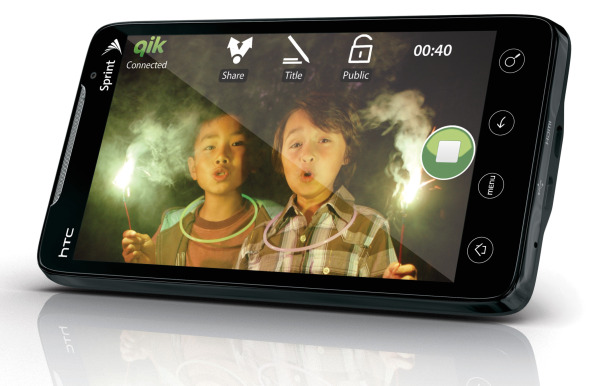 Sprint today unveiled its first 4G phone — the HTC Evo 4G — at the CTIA Wireless show in Las Vegas.
Sprint today unveiled its first 4G phone — the HTC Evo 4G — at the CTIA Wireless show in Las Vegas.
In addition to blazing fast 4G connectivity — which reaches speeds up to 10 times as fast as typical 3G networks — the phone is also a powerhouse device that bests Google’s Nexus One “superphone” (also built by HTC) in practically every way. If there can be only one Android superphone, the Evo 4G is it.
According to Engadget, the Evo 4G sports a 4.3-inch display and runs at a 480 x 800 resolution like the Nexus One (which has a 3.7-inch screen). It also features an insane 8-megapixel camera with flash (compared to the Nexus One’s 5-megapixel camera), which supports 720p high-definition video recording. And if that’s not enough, there’s also a front-facing 1.3 megapixel camera meant for video conferencing.
Beneath the hood, it runs a 1 gigahertz Snapdragon processor, and has 512MB of RAM and 1GB of storage (twice the storage of the Nexus One). The Evo also comes with an 8GB microSD card for storage, and will of course allow you to swap in larger cards whenever you want. And like many upcoming ultra-powered Android phones (and the Nexus One), it runs Android 2.1 — the latest version of the operating system — with HTC’s Sense UI for extra visual panache.
And for those of you interested in Sprint’s MiFi wireless hotspots, the Evo 4G will also feature Sprint’s hotspot application, which offers similar functionality. The app will allow up to eight users to tether wireless devices to the phone. There’s no word if this app will cost something extra to access, but it will undoubtedly be a killer feature for the phone come launch.
Sprint isn’t being specific with a launch date — its reps reiterated that the phone is coming “this summer.” But as I discussed in our coverage last month, a summer launch would still be well ahead of its competitors. AT&T isn’t expected to roll out its 4G solution until 2011, and Verizon’s roll out will likely start sometime this year.
It’s no surprise then that Sprint is the first to launch a 4G phone — at least, as far as we know. Some semblance of 4G connectivity could make its way into the next generation iPhone — but even then it wouldn’t really be useful until AT&T starts making its 4G network available in 2011.
The Evo 4G has the potential to be a killer device this summer, and it’s something that could easily convince customers to jump over to Sprint. It also marks the new standard against which all killer mobile devices will be set.

VentureBeat's mission is to be a digital town square for technical decision-makers to gain knowledge about transformative enterprise technology and transact. Learn More
